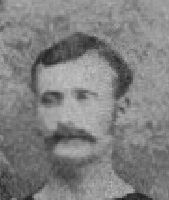NOTE: The gravestone of John Gow is lying face-down when it should be proudy upright. That it remains so is a disgrace on the part of our national footballing establishment and the operators/responsible organisation of and for Cathcart Cemetery, East Renfrewshire Council; one which can easily be corrected by a relatively small amount of money from the former and some restorative cooperation between the both.
John Gow

John Gow is one of those, who might perhaps have been a Rangers player but for elements of both serendipity and choice. Born in 1859 he lived much of his early life in Kinning Park, close to where the Gers played until the move to Govan in 1887 and north and west of the railway lines that seemed then to form the natural frontier between today's Ibrox club's catchment and that of Queen's Park. Yet Gow, in 1880 would join Scotland's doyen, remain with them for seven seasons and spend the rest of his life in Glasgow's southern suburbs.
But the key to it was perhaps his path to arrival at the second Hampden. For unknown reasons, although perhaps his work, he was a clerk, his football began not locally but with Maxwell, playing on Glasgow Green but with, it is said, its own ground in the southern suburbs by Haggs Castle. And from there he moved to Parkgrove, with its Trinidad Park ground probably actually in Govan but with a cosmopolitan team with players in it that clearly attracted Queen's Park's interest as it in 1880 rebuilt from outwith. John Gow was one, as was his then full-back partner, Andrew Watson.
But, whereas Watson went straight into the Queen's Park eleven, Gow when he followed him shortly after did not. He was peripheral for a couple of seasons, playing occasionally and as the left half-back in a two. David Davidson and John Holm were seemingly otherwise preferred. Indeed it was only from 1882-83 that he began to form a still half-back partnership now with Charles Campbell that endured. As a pair they took the Scottish Cup in 1884, albeit by a walk-over, and again in 1886, lost the 1884 FA Cup Final and faced England in the 1885 international.
Gow's time with Queen's Park came to end in 1887 through illness. And, whilst he did recover, he then was to turn out for Battlefield, based in Langside, so The Spiders' neighbours, and then in 1889 become a founder of Cathcart. By then he had married, in 1884 to Jeannie Esilman. They then moved permanently to the southern suburbs and there were to have four children, three boys and a girl. And John also changed occupation. He would move into the wine and spirits trade, where he prospered and would remain until retirement. He would die 1932 at the age of seventy-two and be buried in Cathcart Cemetery. However, once again the exact site of his grave is at present unsee-able. It is known to be near that of Wattie Arnott but in the guddle there of toppled stones, in urgent need of lifting and restoration.
Birth Locator:
1859 - 17, Houston St., Kinning Park, Glasgow
Residence Locations:
1861 - 17, Houston St., Kinning Park, Glasgow
1871 - 96, Houston St., Kinning Park, Glasgow
1881-84 - 81, Pollok St., Kinning Park, Glasgow
1887 - 20, Dixon Ave., Govanhill, Glasgow
1888 - 12, Queens Crescent, Cathcart, Glasgow
1891 - 23, Queens Crescent, Cathcart, Glasgow
1901 - "Stencairn", Eaglesham Rd., Clarkston, Glasgow
1911-15 - 97, St. Andrew's Drive, Pollokshields, Glasgow
1919-28 - 4, Boleyn Rd., Strathbungo, Glasgow
Death Locator:
1932 - 82, Norham St., Shawlands, Glasgow
Burial Locator:
Back to Cathcart Cemetery,
or the SFHG Home page